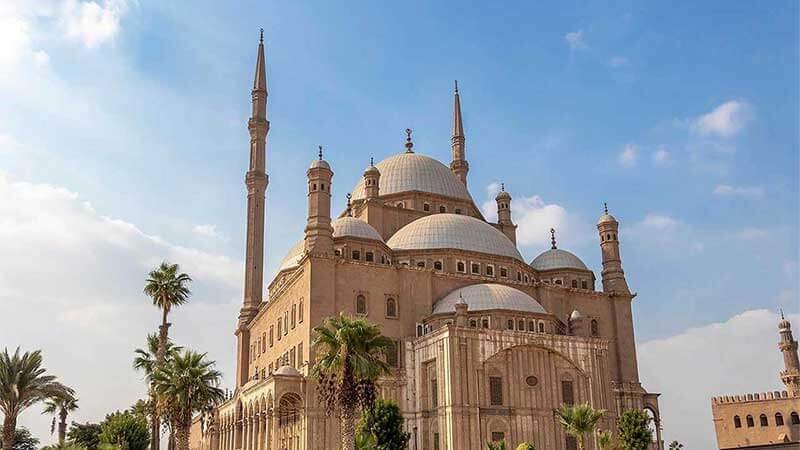Welcome to the captivating world of the Saladin Citadel, an iconic historical monument that proudly showcases Egypt’s illustrious past and architectural brilliance. Rising majestically atop the Mokattam Hills in the heart of Old Cairo, Egypt, the Saladin Citadel, also known as the Citadel of Cairo, has witnessed centuries of history and has left an indelible mark on the country’s cultural tapestry.
In this article, we embark on an exhilarating journey of exploration, peeling back the layers of time to reveal the intriguing history, awe-inspiring architecture, and profound cultural significance of the Saladin Citadel. Join us as we delve into the heart of Cairo’s mighty fortress to unlock its well-guarded secrets.
Don’t forget to read our related blogs:
Saladin Citadel: A Window into the Past

The history of the Saladin Citadel is intimately intertwined with the legacy of one of Egypt’s most revered figures, Salah ad-Din Yusuf ibn Ayyub, more commonly known as Saladin. This remarkable leader, a renowned military strategist and the founder of the Ayyubid dynasty, oversaw the citadel’s construction between 1176 and 1183 AD during the Fatimid Caliphate’s reign.
Strategically perched, the citadel was designed as a formidable defensive stronghold, offering unparalleled protection to the city against potential invaders. Its commanding location atop the Mokattam Hills provided an eagle-eye view of Cairo, enabling vigilant surveillance and safeguarding of the entire metropolis.
The Marvelous Architecture of the Saladin Citadel
The Saladin Citadel boasts breathtaking architecture that reflects the ingenuity and craftsmanship of its time. This fortress seamlessly blends various architectural styles, bearing witness to the diverse influences of the era. Key architectural elements of the Saladin Citadel include:
- The Great Mosque of Muhammad Ali Pasha: Standing as one of the citadel’s most prominent landmarks, the Great Mosque of Muhammad Ali Pasha, also known as the Alabaster Mosque, is a stunning example of Ottoman-style architecture. Built in the early 19th century, it continues to be an iconic symbol of Islamic architectural grandeur. Its imposing dome and minarets grace Cairo’s skyline, captivating visitors with majestic beauty.
- The Military Museum: Nestled within the citadel’s walls lies the Military Museum, a treasure trove of historical artifacts and weaponry. The museum takes visitors on a captivating journey through Egypt’s military history, chronicling the nation’s battles and triumphs.
- The Al-Gawhara Palace: The Al-Gawhara Palace, also known as the Jewel Palace, is a magnificent structure that exudes the luxury and splendor of the Ottoman era. Adorned with intricate decorations and lavish interiors, the palace offers a glimpse into the lives of Egypt’s rulers.
Unraveling the Cultural Significance
The Saladin Citadel is an architectural marvel and a site of profound cultural importance for Egyptians. It is a testament to a pivotal period in Egypt’s history when Islamic rulers left an indelible imprint on the nation’s identity. The citadel embodies ancient civilizations’ strength, resilience, and artistic brilliance.
The Saladin Citadel Today: A Living Heritage
Centuries have passed, yet the Citadel proudly stands, beckoning visitors worldwide. Today, this fortress is a living testament to Egypt’s rich heritage, hosting cultural events, exhibitions, and festivals celebrating the nation’s storied past.
Visitors can immerse themselves in the citadel’s many attractions, marvel at its architectural splendor, and gain profound insights into history’s annals. The breathtaking panoramic vista of Cairo from the citadel’s vantage point is a sight to behold, offering an unforgettable experience.

Frequently Asked Questions
When was the Saladin Citadel constructed, and who was its architect?
The Saladin Citadel was built between 1176 and 1183 AD, during the rule of the Fatimid Caliphate, under the supervision of Salah ad-Din Yusuf ibn Ayyub, popularly known as Saladin.
How can I access the Saladin Citadel?
The Saladin Citadel is easily reachable from various parts of Cairo. Visitors can conveniently take a taxi or public transportation to reach the citadel’s entrance.
Is the Saladin Citadel open to the public?
The Citadel warmly welcomes visitors. Tickets can be purchased at the entrance, granting access to the citadel’s numerous attractions.
What are the must-see attractions within the Saladin Citadel?
Some must-visit interests within the Citadel include the Great Mosque of Muhammad Ali Pasha, the Military Museum, and the Al-Gawhara Palace.
Are guided tours available at the Citadel?
Indeed, guided tours are readily available at the Citadel for those eager to delve deeper into the fortress’s history and architectural wonders.
What are the best times to visit the Saladin Citadel?
For a truly enchanting experience, consider visiting the Citadel during the early morning or late afternoon when the weather is mild, and the sunlight bathes the fortress and the sprawling city of Cairo in a magical glow.
In Conclusion
The Saladin Citadel is a testament to Egypt’s extraordinary history and architectural prowess. From its humble beginnings as a protective fortress to its current role as a cultural icon, the citadel’s journey is awe-inspiring.
As you stand within its ancient walls, gazing upon the panoramic views of Cairo below, a profound sense of connection to the past envelops you, allowing you to truly appreciate the magnificence of human ingenuity. The Saladin Citadel encapsulates the spirit of Egypt, its people, and its enduring legacy, inviting you to be a part of this captivating story.


